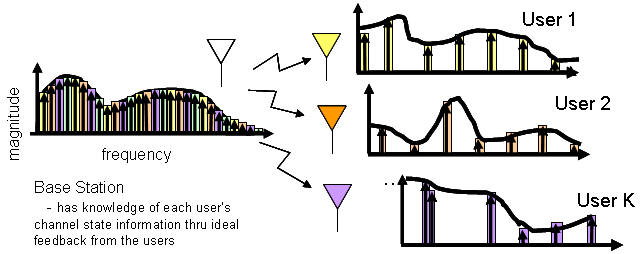Cellular long-term evolution and Wimax basestations employ an extension Orthogonal Frequency Division Multiplexing (OFDM) known as Orthogonal Frequency Division Multiple Access (OFDMA) or Multiuser OFDM. OFDM divides the transmission bandwidth into non-overlapping narrowband subchannels. Each narrowband subchannel may carry data, or a reference/pilot signal, or neither. Subchannels with excessive noise and interference can simply go unused. Some standards allow more bits to be placed on subchannels with higher signal-to-noise ratios. OFDM is used in IEEE 802.11a/g wireless LAN systems.
In current OFDM systems, only a single user can transmit on all of the subcarriers at any given time, and time division or frequency division multiple access is employed to support multiple users. The major setback to this static multiple access scheme is the fact that the different users see the wireless channel differently is not being utilized. OFDMA, on the other hand, allows multiple users to transmit simultaneously on the different subcarriers per OFDM symbol. Since the probability that all users experience a deep fade in a particular subcarrier is very low, it can be assured that subcarriers are assigned to the users who see good channel gains on them.

Our research considers the basestation allocation of subcarriers, power, and data rate to each user to maximize the sum of user data rates, subject to constraints on total power, bit error rate, and proportionality among user data rates. Our initial solutions assumed perfect channel knowledge, modeled instantaneous data rates, and relied on low-complexity heuristics, as described in the following papers:
- Z. Shen, J. G. Andrews, and B. L. Evans,
"Adaptive Resource Allocation in
Multiuser OFDM Systems with Proportional Rate Constraints",
IEEE Transactions on Wireless Communications,
vol. 4, no. 6, pp. 2726-2737, Nov. 2005.
- I. C. Wong, Z. Shen, J. G. Andrews, and B. L. Evans, "A Low Complexity Algorithm for Proportional Resource Allocation in OFDMA Systems", Proc. IEEE Int. Workshop on Signal Processing Systems, Oct. 13-15, 2004, pp. 1-6, Austin, TX USA.
In Fall 2006, we developed low-complexity algorithms for the optimal solution for both perfect and imperfect channel knowledge and for both continuous and discrete ergodic (average) rates, based on solving the dual optimization problem. Our solution for OFDMA ergodic capacity maximization problem has O(M K) complexity per OFDMA symbol for M users and K subcarriers, while achieving data rates shown to be at least 99.99% of the optimal rate in simulations based on realistic parameters. Our algorithms are amenable to implementation in fixed-point data and arithmetic, as one would typically find in basestations. Hence, our work attempts to demonstrate that OFDMA resource allocation problems are not computationally prohibitive to solve optimally, even when considering ergodic rates.
The key papers on this approach follow:
- I. C. Wong and
B. L. Evans,
"Optimal
Resource Allocation in the OFDMA Downlink with Imperfect Channel Knowledge",
IEEE Transactions on Communications,
vol. 57, no. 1, Jan. 2009, pp. 232-241.
- I. C. Wong and
B. L. Evans,
"Optimal
Downlink OFDMA Resource Allocation with Linear Complexity to Maximize
Ergodic Rates",
IEEE Transactions on Wireless Communications,
vol. 7, no. 3, Mar. 2008, pp. 962-971.
- I. C. Wong and B. L. Evans, "Adaptive Downlink OFDMA Resource Allocation", Proc. Asilomar Conf. on Signals, Systems, and Computers, Oct. 26-29, 2008, Pacific Grove, CA USA, invited paper.